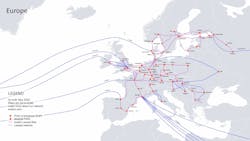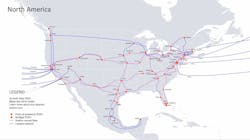Arelion sets long-term sights on businesses and hyperscaler opportunities
Arelion, widely recognized as a wholesale optical and IP-based services provider to carriers, sees an opportunity to sell its high-bandwidth optical and IP services to businesses.
This was a theme it saw throughout 2024.
Mattias Fridström, Arelion’s Chief Evangelist said during the recent OFC 2025 trade show that enterprises' needs are like those of other service providers.
“A bank or car manufacturer buys the same types of products that our carrier customers do,” he said. “We have seen some success with agents and selling directly to these customers.”
Enterprise growth potential
In the enterprise space, Arelion continues to succeed in selling its products to businesses directly and via agents.
Arelion’s Channel Program established partnerships with several Technology Services Distributors (TSDs), including Sandler Partners, AVANT, Telarus, App Direct, Bridgepoint and Intelisys. The provider’s efforts included it in the 2025 CRN Partner Program Guide.
Fridström said the enterprise represents “a huge growth potential for us.”
The service provider has cited over 1,000 potential opportunities but cautions that locating them is challenging.
Enterprises purchase extensive bandwidth-based Ethernet and optical wavelength services like their wholesale customers.
While Arelion will remain a key wholesale provider, Fridström, emphasized that it can “sell the same types of services and understand how to handle our services.”
Preparing for hyperscalers
Besides seeing enterprise growth, Arelion remains a major player in the hyperscale market segment.
After meeting its revenue and traffic goals, Fridström said its new owners are willing to support new initiatives it wants to pursue.
In 2020, Telia sold Arelion, then known as Telia Carrier, to Polhem Infra, an infrastructure investor owned by Swedish pension funds.
“We had a great year in terms of traffic and revenue growth and the bottom line and revenue,” Fridström said. “The new owners will support more risk-taking investments if they can produce a good payback.”
Arelion sees growing potential to extend its fiber and IP network to more hyperscalers as they scale their respective AI business.
Fridström said the new ownership has allowed it to pursue hyperscaler demands. “The door has been opened for us to do things we could not do five years ago when Telia owned us,” he said.
Leveraging and supporting AI
Like other providers, Arelion will be ready for the upcoming AI boom.
While the service provider sees AI's potential to drive more traffic across its networks from enterprise and wholesale customers, it has not seen that trend yet.
“We hope AI will generate a lot of traffic, but we have not seen that yet,” Fridström said.
In the near term, Arelion sees the immediate impact that AI could have on its network, particularly its ability to alert its customers of any issues.
“The other side of AI is we can introduce it into our operations,” Fridström said. “We can care for our customers much better, and AI can correlate information from their systems and resolve problems before they even call us.”
He added that AI also has the potential to conduct preventative maintenance. “The dream scenario is to swap out network elements before they break,” Fridström said. “We’re very early into these discussions, but we see a lot of opportunities with automation going forward.”
Reimagining European assets
Telia can look within its network footprint to support its hyperscaler and enterprise efforts.
Over two decades ago, Arelion pre-built a fiber conduit that it can now use.
“We have some interesting infrastructure in Europe where we were building the network 25 years ago,” Fridström said. “You can put a cable in an empty duct, which is much cheaper than building new infrastructure.”
When building its European network, Arelion built extra facilities to accommodate future growth. It put in six that were left empty, and only used one.
As DWDM generations continued to advance, the only thing that changed in various fiber pairs was the electronics.
However, new limits on the equipment and demands from hyperscalers supporting AI change the script. “Usually, you just swapped out equipment, but as Shannon’s limits are here, we start to consume fiber at a different pace than before,” Fridström said. “If the hyperscalers want to buy new fiber in 2025, they want to know those fibers will be around in 2050.”
He added that this creates a new opportunity to put a new cable in an empty duct, representing “unique assets in Europe for hyperscalers that they can’t get anywhere else.”
Arelion's new owners share a similar long-term investment thesis, enabling it to do this. These latest moves require the provider to invest between $15 and $20 million.
“The former owners were not interested in having us spend several million dollars on something that generates long-term revenue,” Fridström said. “Long-term revenue sounds good to our new owners, and we don’t need an immediate six-month payback.”
Pushing optical pluggable limits
Arelion has advocated working with its optical manufacturers to access more pluggable technology for its network needs.
Pluggable optics enable high data-rate transmission between servers, switches, and routers.
The service provider sees potential in using pluggable optics to serve its wholesale and enterprise services customers. Today, 50% of Arelion’s network is dedicated to its IP backbone, and the other 50% is for its end customers via Ethernet and optical wavelength services.
Arelion is seeing what it calls “exponential traffic growth” on its IP backbone and in its traditional optical network.
It has been using 400G optical wavelengths in its European network. While the U.S. network still has a 50/50 split between IP and customers’ wavelengths, after moving its IP core to 400G wavelengths, it is selling more 100G wavelengths to its customers.
The service provider is increasingly leveraging pluggable optics. In December, Arelion completed a 400G field trial, achieving 2,253-kilometer IP transmission using Ultra-Long-Haul (ULH) pluggable optics.
Fridström said Arelion sees pluggable optics as a way to lower network deployment costs.
“If we can test things by lowering that cost, including 800G and 1.6 Tbps pluggables whenever they come, it will be good for us inside the network,” he said. “Every cent counts when you have that amount of traffic.”
He added that while leveraging pluggable optics is a priority, getting them from the vendors can be challenging.
“A big focus for 2025 is for us to get more pluggables, but delivery times are an issue,” Fridström said.
For related articles, visit the Business Topic Center.
For more information on high-speed transmission systems and suppliers, visit the Lightwave Buyer’s Guide.
To stay abreast of fiber network deployments, subscribe to Lightwave’s Service Providers and Datacom/Data Center newsletters.
About the Author
Sean Buckley
Sean is responsible for establishing and executing the editorial strategy of Lightwave across its website, email newsletters, events, and other information products.




